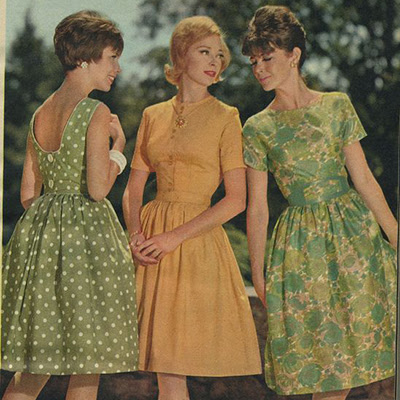A Guide to Vintage Sizing
Ah sizing. Something that is so helpful yet so unhelpful at the same time.
After having so many conversations with you all about the perils of sizing, particularly when it comes to vintage clothing, I have written a little piece about where sizes actually come from, and my tips on finding a sustainable way to find your perfect vintage size!
It is believed that standard sizing as we know it came from wars (particularly the Crimean War), and the need for an easy way to provide uniforms for soldiers. Once 'ready-to-wear' clothing, rather than 'tailor-made', became the norm in the early 1900s, standards bodies saw it fit to create a national sizing chart for men, women and children.
This project began in America after the Second World War, where they surveyed 15,000 women in order to work out the average measurements for clothing. The 'Body Measurements for the Sizing of Women's Patterns and Apparel' was published in 1958 and was available for all to use. Unsurprisingly this was not entirely accurate, not least because the study only included white bodies, and most of the women they used in the study worked in the army during the war so would have been much fitter than the 'average' woman!
Despite its review in 1970, in 1983 the government abandoned it completely, which essentially meant that manufacturers all over the world were left to their own devices when it came to the sizes of their clothes. Not only did this mean that companies and agencies weren't willing to share any data they collected about standard measurements for free (as the process is obviously expensive and time consuming), but 'Vanity Sizing' became a thing.
Vanity Sizing is the idea that brands can make their customers feel good by making their sizes bigger, thereby making them shop there more. Like we have all been into a shop and been pleasantly surprised when we have fitted into a smaller size right? But then other companies want to compete, and they make their sizes bigger, and so on. Below is a chart illustrating how much numerical sizing has increased since the standards were scrapped in 1970.
The inflation of sizes doesn't stop at clothes either - have you ever wondered why vintage shoes are so tiny? It's because our feet have become bigger too! A combination of a better diet from birth and feet growing to support larger bodies has meant that the average women's shoe size used to be a size 3 in the 50s, and is now a size 6.
SO. What does this mean when you're shopping for vintage? Well, not only have people in general got bigger over the years, but sizing has changed dramatically. Plus size 'ready-to-wear' simply wasn't manufactured in the same capacity as other sizes, which means it is so much more rare to find now. But all hope is not lost! There are things you can do to ensure you don't end up with a 70s shirt that keeps popping open or a classic jumpsuit camel toe!
My top tips (which might sound patronising but have literally changed my life) are as follows:
- Buy a tape measure and measure yourself, especially your bust and hips. Keep your tape measure close to where you normally do your online shopping, or take one in your bag when out shopping. If I forget mine I usually ask behind the till if I can't be bothered trying something on!
- If you have a larger legs like me, also measure your top thigh and calf circumference. This isn't a popular measurement that brands have, but I always read the reviews or ask the brand directly for the measurement, and it's saved me from buying some dud jeans and knee high boots!
- Check the fabric - does it have stretch to it? If the description doesn't mention, see if the fabric has elastane in it as that usually means it will have some give! If it's 100% cotton for example, it really needs to match your measurements or be a bit bigger.
- Don't define yourself by a numerical size, it's pointless! Yes it's useful to understand roughly what size you are, but to take it as gospel will just leave you feeling frustrated that all sizes are different everywhere! Below is an example of my point - these are all size 12 jeans from different brands.
Ultimately ALL bodies are different, so in my opinion, numerical sizing as we know it is a useless, manipulative way to get you to shop at certain brands. I have fitted into children's clothes, maternity clothes, plus size clothes, and all sizes in between, so get to know YOU, your measurements and what makes you feel amazing! That's what clothes are all about really :)
Thank you for reading, and while you're here why not check out our groovy clothes! We have introduced a sizing filter now too, so you can filter out your size. Alternatively, shop all and check out the measurements!








Comments
Post a Comment